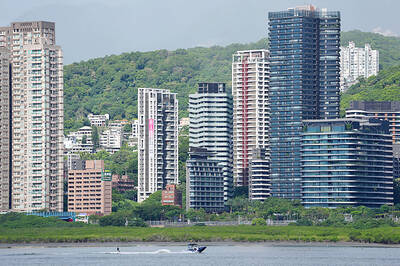Taiwan High Speed Rail Corp (THSRC, 台灣高鐵) said it was reexamining its organizational and personnel structures after it failed to boost falling passenger traffic, the Central News Agency (CNA) reported on Tuesday.
The operator of the high-speed rail system said passenger traffic began its decline in November last year, the first decline since the company launched its service in February 2007, because of the global financial crisis.
Passenger traffic volume has fallen back to the level of April last year, the report said, citing statistics compiled by the company.
Since its launch, THSRC’s passenger numbers continued to grow until the global financial crisis forced local travelers to cut back on trips. The company’s statistics showed that passenger traffic reached an average of 95,000 passengers in one day last August, while passenger numbers also surpassed 90,000 per day in September and October last year. But the situation was reversed in November.
In January, during the Lunar New Year holiday, the number of passengers traveling on THSRC’s trains hit 89,000 per day, but the numbers dropped to a daily average of 85,000 in February and last month.
Although many high-tech firms located in the Hsinchu Science Park have recently reported an increase of rush orders from China, Taipei-based THSRC said it had not seen signs of recovery in the local economy as passenger numbers still remained low.
To lower costs, THSRC cut top executive salaries at the beginning of last month, while reducing the number of trains for the first time since it launched the service by 126 trains per week from March 16, or a 13 percent reduction.
To utilize the workforce more efficiently, the company has increased the number of train attendants from three to four per train and the attendants are now also responsible for cleaning the carriages from Monday to Thursday, instead of an outsourced cleaning crew.
Although THSRC does not plan to cut any staff, it said if economic conditions continue to deteriorate and supply outstrips demand, the company would need to adjust its personnel numbers.

Taiwan’s rapidly aging population is fueling a sharp increase in homes occupied solely by elderly people, a trend that is reshaping the nation’s housing market and social fabric, real-estate brokers said yesterday. About 850,000 residences were occupied by elderly people in the first quarter, including 655,000 that housed only one resident, the Ministry of the Interior said. The figures have nearly doubled from a decade earlier, Great Home Realty Co (大家房屋) said, as people aged 65 and older now make up 20.8 percent of the population. “The so-called silver tsunami represents more than just a demographic shift — it could fundamentally redefine the

The US government on Wednesday sanctioned more than two dozen companies in China, Turkey and the United Arab Emirates, including offshoots of a US chip firm, accusing the businesses of providing illicit support to Iran’s military or proxies. The US Department of Commerce included two subsidiaries of US-based chip distributor Arrow Electronics Inc (艾睿電子) on its so-called entity list published on the federal register for facilitating purchases by Iran’s proxies of US tech. Arrow spokesman John Hourigan said that the subsidiaries have been operating in full compliance with US export control regulations and his company is discussing with the US Bureau of

Businesses across the global semiconductor supply chain are bracing themselves for disruptions from an escalating trade war, after China imposed curbs on rare earth mineral exports and the US responded with additional tariffs and restrictions on software sales to the Asian nation. China’s restrictions, the most targeted move yet to limit supplies of rare earth materials, represent the first major attempt by Beijing to exercise long-arm jurisdiction over foreign companies to target the semiconductor industry, threatening to stall the chips powering the artificial intelligence (AI) boom. They prompted US President Donald Trump on Friday to announce that he would impose an additional

Pegatron Corp (和碩), a key assembler of Apple Inc’s iPhones, on Thursday reported a 12.3 percent year-on-year decline in revenue for last quarter to NT$257.86 billion (US$8.44 billion), but it expects revenue to improve in the second half on traditional holiday demand. The fourth quarter is usually the peak season for its communications products, a company official said on condition of anonymity. As Apple released its new iPhone 17 series early last month, sales in the communications segment rose sequentially last month, the official said. Shipments to Apple have been stable and in line with earlier expectations, they said. Pegatron shipped 2.4 million notebook